<< New Q&A
More Q&A, part 9 >> Part 8
>> Part 7 >> Part 6 >> Part 5 >>
Part 4 >> Part 3 >>
Part 2 >> Part 1
>> Gunwriters guns.connect.fi Link page

Custom Search
Latest update 30.01.2001
G.O.W. Kickback:
Questions and Answers, Part 10
Answered by: P. T. Kekkonen
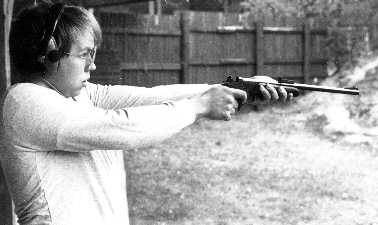 444 Marlin
for T/C pistol
444 Marlin
for T/C pistol
Hello; I have just stumbled on your website and it is the best I have seen in a long time.
We have now similar problems with hoplophobes.
How does Finnish laws treat Thompson Contenders? I have an original TC 12" barrel, 44
Rem Mag, that was rechambered for 444 Marlin. Being scared, I have only loaded up to 1700
fps with 265 gr. Hornady FP (3031). TC does not even want to talk to me, but JD Jones
reckons, I can shoot factory ammo from this thing. Any ideas?
Kind regards, Eugene from South Africa
In Finland is
T/C Contender "a handgun for target practise only". Usually acquired for
Metallic Silhouette shooting. Not (yet) allowed for hunting, but use of it is legal for
shooting of a "Coup de gráce", i.e. put-down shot to any and all
species of wounded game animals. Even the biggest species like moose or bear. Use of
handgun is also allowed for shooting of trapped animals or those pursued into den or lair.
Trapped animals are usually small-game species like minks or foxes. Most usual
"trapper's gun" is a revolver or selfloader pistol caliber .22 Long Rifle. Usual
"Coup de gráce" handgun for big game is a 9 mm Luger caliber selfloader pistol
(many times an original Parabellum P-08 or Mauser C-96/16), although our Game Act allows
use of even the .25 ACP waistcoat-pocket handgun for this very purpose. There is not any
minimum muzzle energy or a bullet weight & construction demand for this very use on
our Game Act.
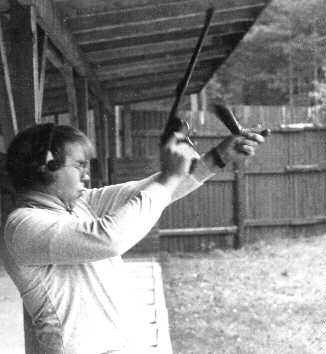
Some T/C Contender pistols with longest available 14" barrels, caliber .30-30 WCF,
rechambered to shoot .308 Winchester cartridges and equipped with a non-detachable
buttstock were made in Finland in early 1980s for moose hunting, until arrival of
amendment of Firearms Act, giving to us the minimum barrel lengths and overall lengths of
shoulder arms. In 1998 the demand of minimum barrel length was shortened somewhat, to 400
millimeters, and gunsmiths were learned to extend the barrel lengths by mounting of muzzle
brake/ recoil compensator or, since 1993, by mounting of an integral suppressor to extend
the barrel up to the legal dimensions. Use of a suppressor has been legal, even on the
hunting firearms, since 1st August 1993.
GOW archive photo: This T/C Contender chambered for 45-70 Government
did not like full power+ loaded heavy bullet ammo. This lucky snapshot shows the pistol
breaking off it's front grip by recoil. One-of-a-lifetime photographer's occasion.
J.D. JONES is definitely a TOP authority on T/C Contender! If he says "yes" it
means: YES! All the listed handloads of .444 Marlin generates less than 40 000 CUPs
chamber pressure, while some .308 Winchester factory-loads may generate 55 000+ CUPs.
According to the S.A.A.M.I. standards were maximum allowed average chamber pressures (20
years ago) 55 200 CUPs for .308 Winchester factory-loads and mere 47 200 CUPs for
factory-loaded .444 Marlin cartridges.
I have shot at least a hundred rounds of .308 Winchester factory-loaded cartridges from a
T/C C carbine, buttstocked from a .30-30 WCF caliber (rechambered) T/C Contender pistol. I
have still a hairy head on my shoulder, two intact blue eyes (slowly blindig by the Diabetes
Mellitus, however) on my face, and all five full-length fingers on my both hands.
1601 MMI; PT
Fyell-deer loads for an "Elephant Gun"
Pete Kekkonen, I found your great web site today. I'm hunting a deer (small European deer)
in close proximities to houses on a special hut, organized by the community. I have been
using a reduced load in my .340 WM at about 700 m/s with a 225 gr Hornady SP propelled by
52,5 grains of N 135. This loads performs well and is reasonably accurate (1,5 MOA).
However, it is still too loud! I'm in the situation where I can try even more reduced
loads like 15 - 18 grains of N310 (+ dacron) behind a cast bullet weighing 235 grain. Or I
can get a supressed Ruger bolt action in .44 Magnum rifle at a reasonable deal.
My questions are: Am I in the ballpark with the N 310 load in the .340 and is it safe?
Should I forget the .340 for reduced loads due to the huge capacity and just get the .44
Mag.? I expect the .44 Mag to be more effective at low velocities. I can get cast bullets
for the .44 Mag. weighing from 180 grain to 400 grain. For a subsonic hunting load - what
will be the best bullet weight to go, and with what powder charge?
Yours sincerely, Vegard from Norway
"All
those f**king Weatherby calibers are risky calibers for reloaders", according to many
ballisticians, while: "Behaviour of a 20 x 138 mm Solothurn Long cartridge is easily
predictable". However, use of a cast bullet may be the way to useful low-noise load
for hunting of Norwegian fyell-deer/ fell deer, along with ALL known special tricks, like
dacron-filling & use of the most efficient available Magnum primers, Federal N:o 215,
and drilling of the priming-flash hole to diameter 3½ millimeters. Your estimated charge
15 to 18 grains of VihtaVuori N310 powder seems to be O.K. behind 235-grainer CAST bullet.
Try first 18 grains charge and reduce it (if needed) down to 15 grains. Always shoot at
least five rounds of cartridges to the target with each load lot and adopt the charge
which generated least dispersion (= smallest group = best accuracy).
I presume that you don't need to acquire a .44 Magnum rifle, because the smallest
applicable loads of .340 Weatherby Magnum are not noisy, if you use those lead alloy
bullets ONLY!! 15 grains of N310 is not yet the definitely minimum charge. So you may get
a subsonic bullet velocity and accordingly reduced noise of shooting. I cannot recall,
whether use of the suppressor is banned or allowed in Norway, like it is allowed in Sweden
and Finland. With a suppressor mounted and cartridges loaded to give subsonic velocity
level, the very most noisy "shooting signature" is a smack of a bullet, striking
on the side of a fyell-deer.
A little bit of Zoology
These animals exists also in North-East Finland: Petra or peura (Rangifer Tarandus
variatio Fennica). Once upon a time they were slain to almost exhaustion with crossbows
and muzzle-loader rifles, shooting spherical lead bullets, calibers from 7 mm to 10 mm.
Last specimen of original Finnish wood-petra population was shot in 1921. But there was a
strong population of wood deers also in Russia. During recent decades those deers were
immigrated to Finland. Nowadays we have so dense population of Finnish deers that limited
hunting of them is possible. Domestic raindeer is actually a tamed Norwegian fyell-deer
(Rangifer Tarandus), bred to grow bigger than wild deers. In Finland are found also
cross-breeds of raindeers and Finnish deers.
In South-West Finland lives a very dense population of whitetail deers, brought in 1930s
from Minnesota, USA, reproduced from 32 imported animals. Whitetails and Rangifer deers
are unable to become cross-bred, as far as I know. Name "Petra" was a trademark
of Finnish selfloader hunting rifle, made by Valmet Oy and later by Sako Oy; nowadays
discontinued. (In USA the trademark was vulgar "Valmet Hunter"). I was a
"godfather" of this very rifle model, proposing the archaic/ original name of
Finnish deer for it. In modern Finnish is the common name for all kinds of deer, including
the foreign whitetail, simply a "peura". Reindeer is, however, a
"poro" in Finnish.
1701 MMI; PT
Selector/safety of KP/-31
I need the scheme of firing selector of Suomi Submachine Gun
KP/-31. Can you send it to me?
Carlos from Spain.
Si, we can!
Selector/safety is a sliding L-shaped piece of steel ahead of a trigger. Positions of it
are:
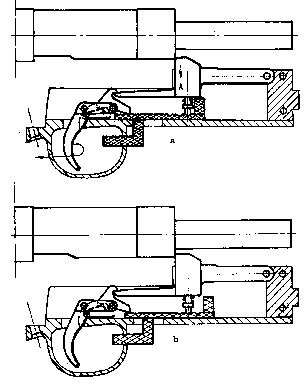
SAFE = rearmost position. A slide inside the trigger mechanism prevents
movement of the trigger and sear. It is impossible to cock the breech-block or discharge
the gun, when safety is applied. (Fig. a)
SEMI-AUTOMATIC FIRE = mid-position. The selector slide allows movement of
sear and trigger, but it disconnects trigger from the sear soon after the breech-bolt
starts it's movement forwards. The sear can move upwards to catch returning bolt. When the
trigger is released, it is again connected to the sear for next shot. (Fig. b)
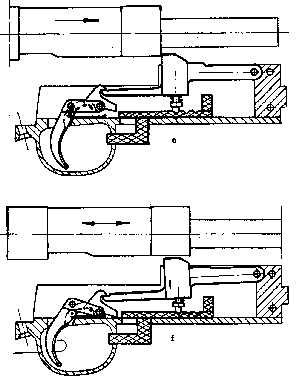
FULL-AUTOMATIC FIRE = frontmost position. Selector slide cannot reach the
disconnector, which pull the sear downwards. Shooting continues until the trigger is
released or magazine of the gun is empty. (Fig. e and f)
0201 MMI; PT
Reduced loads for a buffalo gun
Just a note from a Texas shooter that appreciates the information on light loads or
reduced loads. I have been playing around with some light loads for my little .458 Win
Magnum. Since the huntable elephant population in Texas is 0 at this time, I thought it
appropriate to create some lighter 45-70 type loads for wild hog, Russian boar, and deer.
Using 300 gr JHP or 405 gr lead bullets and 2400 powder I now have loads appropriate for
medium game. I was not happy however. I wanted one gun that I could use on everything. I
now have a couple of loads that use either a .458 round ball or an old style collar button
bullet, in conjunction with "Bullseye" powder. I now am in the process of
testing and the preliminary results are encouraging.
These loads are chronographing around 275 to 300 m/s, and should be ideal for rabbit and
other small game.?Imagine, one gun that takes everything from squirrel and rabbit to
elephant and cape buffalo. It makes you want to kneel down and say, Thank You Jesus, and
God Bless Texas! Anyway I am going to fine tune these loads and will send you the
specifications for the light loads. You have a great site with fantastic information,
after I saw you had some good things to say about one of my heros (Larry Thorne) I knew
for sure you were not some Commie Bastard hiding out in Finland.
Best wishes for the New Year,
Kevin, Dallas, Texas
Comments of
Chief Editor: Your experiences about versatility of .458 Win. Magnum are
welcome to our website. One of my friends in Finnish Lappland loaded also his .458 WiMa
cartridges with wide variety of reduced charges, starting his experimental work almost 20
years ago. Powder used was VihtaVuori N320, with burning rate somewhat slower than that of
"Bullseye". So my friend reduced volume of the case with?pieces of soft Mipolam
(PVC plastic) hose, squeezed into lubricated and somewhat heated cases. Diameter of these
"case liners" was 12 millimeters (outer dia.) and 9 mm (inner dia). Length of
liners was about 50 millimeters. Usual bullets were Sierra Jacketed Softpoints or
Hollowpoints, with weight 300 grains.
For big-game hunting these bullets are miserable projectiles if their striking velocity is
too high, but at "soopoo" (subsonic) velocity the 300-grainer Sierra JSP or JHP
is OK even for hunting of moose or Finnish bear (Ursus Arctos). Correct placement of hit
is, of course, essential and the distance of shooting should be short. My friend had a
team of dogs harnessed to the sleigh. It is illegal to shoot game animals from?motor
vehicles like "Ski-Doo", but hunting from a dog-sleigh is allowed in Finlad.
Shooting distance was usually less than ten yards.
"Imperial" dimensions of liners are: Outer diameter .47, inside diameter .35 and
length 2 inches, approximately. When you load lined cartridges, you may/should reduce the
powder charge according to the reduced case volume. PVC (hose) liner shall last as long as
the case itself, and it allows depriming with usual equipment. We don't know, how
long-lasting may be the India Rubber hose (of red natural rubber). Big bullet does not
make the rifle unfit for hunting of small-game animals like hares, rabbits or squirrels.
Your .458 WiMa is OK for purpose.
My 12.17 x 44R Swedish Remington rifle may be also a good squirrel rifle, when loaded with
.500" diameter spherical cast lead-alloy bullet, but I have not a legal right to
shoot this ancient wall-hanger, made by Carl Gustav Stads Gevarsfaktori, Eskilstuna,
Sweden, in 1875. I have not cartridges or even the cases for my "Svensky
Remington", although the new high-quality cases for it are available from Australia.
In Sweden was 12.17 mm rifle a popular instrument for hunting (or poaching) of all kinds
of game animals, big or small, usually with the spherical lead bullets and blackpowder
handloads about a century ago, but presumably still later. Factory-loaded cartridges have
been unavailable since 1st World War; I presume.
Remington rifle was also a good appliance for fishing of the pikes, spawning on the
flooded area at riverside meadows. Swedish television (Svenska Radio) produced in 1970s a
document "Remington-Olle" about an old poacher & fisher, who shot the pikes
with his old Remington, using black powder and spherical cast bullets. This kind of
fishing was, of course, illegal in Sweden, but the story was produced by an exceptional
allowance - to show "fishing methods of by-gone days" - and the versatility of
ancient Remington rifle. I presume that .458 WiMa rifle may be also a fine fishing
appliance, but use of it may be illegal for this purpose in Texas too.
0501 MMI; PT
Send my for question load sub-sonic:
Lapua case .308 Winchester. Lapua B-416 sub-sonic is possible change D-46 185 gr? Primer
CCI BR-2 Large Rifle or Magnum primer? Charge 10.6 grains of N310 or N320? O.A.L. 2.620
Best Regards: Roberto from Italy
185 grs Lapua
D-46 is preferable. B-416 is unstable when shot from a bore with more than 240 mm twist of
rifling. This bullet was actually designed for 7.62 x 39 mm and 7.62 x 53R cartridges.
CCI BR-2 primer is sufficient if the primer pocket's flash hole ("vent") of case
is enlargened to 3.5 mm diameter. Charge 10.6 grains is correct with both of these
VihtaVuori powders, owing same chemical composition, but different size and shape of
kernels: N310 is a "stick powder" with very thin solid kernels, while N320 has
more large tubular kernels.
Sensitivity of ignition is similar: Powders are very flammable, because of their rough
kernel surfaces. Burning rate of N320 is slightly slower than rate of N310, but this
difference is too small to cause nasty surprises unless the charge is considerably below a
safe minimum. 10.6 grains of powder, either N310 or N320 is not definitely a minimum load,
but a starting load for search of a good subsonic charge. You may lessen it, or add
slightly more powder if needed. Lower limit is ca. 9.5 grains and maximum charge ca. 12
grains. Lubrication of bullets is always beneficial way to keep the bore condition/ bullet
velocities uniform.
2812 MM; PT
Long Tom
Grandpa Bert is wondering where the term "Long Tom" comes from? We are aware of
an old 12 gauge shotgun that the owner refers to as a Long Tom shotgun.
dg.
This pet name
of Pennsylvanian-Kentuckian long-barreled rifle or shotgun is presumably born during
flintlock era. Some gunsmith owing first name or family name Thomas had built a bore drill
and rifling bench for making of extra-long squirrel rifle barrels? (In 1700s and early
1800s should gunsmiths usually made their own "machinery" first). "Long
Tom" barrels could be as long as 60 inches. In the mid-1970s offered Dixie Gun
Works, Inc. on their catalog No. 124A drilled and reamed octagonal barrel blanks,
presumably made in Spain, size across the flats 13/16 inch. Caliber was .43 and length
full five feet. This smoothbore "Dixie Five Foot Long Tom Rifle Barrel" blank
was available at $ 19.95 without thread for a breech plug.
Rifles with 1.52 meter long barrels were not very handy in the woodsland. They were also
difficult to load and clean the bore. Long Tom rifles never became popular, because their
accuracy and range were not enhanced. In Finland this name is unknown, but we have an
exclusive kind of handmade sheathed knife "TOMMI puukko" still in
production by knifesmith family Kemppainen or Keranen in Kainuu region,
Finland. Name "Tommi" derives from a British foreman Thomas
Woodward who moved from Sheffield, England in 1862 to Finnish Fiskars
manufacture to learn hardening technology of then-new Bessemer and puddled carbon
steels. In 1875 he became a manager of Hackmann's Nurmi factory.
Woodward died in 1878. He was taught technology of hardening and tempering by
oil-quenching to many workers of Fiskars and Hackmann factories. One of them, Kalle
Keranen, returned to Kainuu region, starting puukkosmithing. "Official
name" of this very puukko desing is "puukko of Kainuu", but "Tommi-puukko"
is well-known pet name of these knives with very keen and hard high-carbon steel edge.
Tommy Woodward didn't design this traditional knife, but he taught to knifesmiths of
Kainuu a successful hardening & tempering method for knife edges.
Designer of Long Tom rifles and shotguns is unfortunately unknown to me, but there was
probably some person behind a name.
1612 MM; PT
Berthier and Chatellerault
I have two rifles that my father brought home from France after WW II and I am trying to
find some general information on them. I read one of your responses about the Berthier
Rifle on your question and answer page and thought that you might be able to help me out.
I have a carbine that is a Berthier Model 1892, Artillery Musketoon (Mousquetons d'
Artillerie). Manufactured by Manufacure d' Armes Saint Etienne sometimes
between 1892 and 1916. I was told that a Mle. 92 is somewhat rare and not a common find.
The other rifle is a long rifle that is also chambered for the 8 x 50R Lebel cartridge. It
has the serial number 85026 stamped all over it. It has the words Chatellerault
MLE 1907 15 and came with a MLE 15 Epee Bayonet. I am told by an expert "This is most
likely a Berthier Model also as Chatellerault did not make Model 1907 Rifles." If
this is true why is Chatellerault inscribed on the barrel?
Thank you for any information that you might have. I am trying to document as much
information as possible on my collection of guns to leave for future generations.
Greg from Iowa.
There was not
any "Manufacture d'Armes Berthier" in France. Berthier was just a
designer of clip-fed rifles and carbines. State-owned manufactures/arsenals assembled
them. During the First World War (the BIG ONE) was not uncommon that some manufacture
assembled some models of firearms but the parts (including barrels) were made by another
arsenal, owing more production capacity of these parts. Example given: Chatellerault
might have extra capacity for drilling & rifling of the barrels, while St. Etienne
had insufficient capacity to produce them. So St. Etienne bought barrels from
Chatellerault. Because barrel is an essential part of a rifle, it was necessary that name
of it's manufacturer is inscribed on it. In France was even the name (code) of cartridge
case manufacture and sometimes source of brass material headstamped on the cases, which
were primed, loaded and bulleted elsewhere.
This subcontractor method was also usual in Imperial Russia during 1st World War: Finnish Tikkakosken Rauta- ja Puuteollisuus Oy made breech-bolts
and cast brass or bronze feeder frames for Russian Maxim machine guns. In independent
Finland made a sporting rifle shop of gunsmith Joonas Matarainen (later Mikro
Oy) barrels for Suomi KP/-31 submachine guns. There were at least two barrels issued
for each KP/-31 and usually at least one barrel for shooting with blank cartridges.
Tikkakoski Oy had not enough production capacity to drill and ream all the barrels &
cut the rifling grooves and lap the bores just like bores of high-quality target rifles
were lapped in Finland.
Subcontractor Mikro Oy's KP/-31 barrels was urgently needed especially during the Third
Finnish Independence War 1941 - 44, when the submachine guns were mass-produced also for
export.
1212 MM; PT
Please: Don't cease!
Hello! I stumbled on your site while searching for the subject of reduction of muzzle
velocity, and find it a most excellent resource. I hope you are able to continue and gain
patrons. I would be willing to put up the $US 20 if only for the information already
gained against the prospect of picking bits of a chamber out of my face with tweezers
because of S.E.E.
I have not searched your site exhaustively with an eye for current developments,
concentrating more on the wealth of loading information, and I am wondering if you have
any better idea now what your prospects are regarding the future of your site.
I do have some specific questions, and will continue to do research of course, and not
presume on your hospitality without having "done my part" for your site. I find
it unfortunate that people have developed the attitude that the freedom of this wonderful
medium of information dissemination implies freedom from cost. It seems there is much
excellent knowledge available from your country, and it would be shameful for it to be
lost to the rest of us because of that attitude.Killing the goose that laid the golden
egg, indeed! Many thanks if it is within your ability to respond!
Th. A M
and comment:
Welcome to The Club! Privileged visitors of GOW/ Universal are always privileged to enjoy
our service! Your fingers and eyes are presumably a lot more valuable than a printed
picture of the late U.S. President Andrew Jackson. I've not met any printed
Handloading Manual containing data for SWOS loads, "Cat's
Sneezes" or other information we have offered. And especially in Finland it is an
opinion that "this data for the terrorists and poachers shall never become published
on the printed manuals". GOW shall therefore possess still a monopoly as a
distributor of scientifically researched data on the subsonic handloads of rifle
cartridges.
1212 MM; PT
Bergmann MP article in English too?!
I was happy to find the Gunwriters Suomi site. It covers more
information than I have found anywhere on the model 31 or 44. I cannot seem to translate
the site for the MP-18 though, and was hoping there was a site in
English, or would be soon. Do you have anymore sites that are that informative, in
English, for any other weapons?
Thank You. M.E.
Sorry; I have
no time to translate articles as large as the Bergmann MP story into English. There are no
more than 24 hours in a day & night. Our Finnish visitors are up-keeping our site.
They are therefore always privileged to get information.
1712 MM; PT
Hydrodynamic .22 rimfire bullets
Hi PT, In an earlier post you mentioned making "exploding" .22 rimfire bullets
by filling the hollowpoint with common vaseline. Does the hollow need to be enlarged for
this to work? In the states we have achieved similar results by filing the tip of the
bullet flat. Thanks very much.
Dave
Enlargement of hollowpoint is unnecessary but deepening of it is beneficial, if not
essential. In 1980s had just Lapua .22 LR HP bullets deep enough point cavity, with
diameter no more than 1/10" or one Russian "linya", but with
average depth seven millimeters, up to .28 inch. Ancient Record injection syringe with 2
cc capacity was an ideal instrument for vaseline/ "mineral jelly" filling to
narrow point cavities of these bullets of my pet Lapua "Sound Moderator HP"
cartridges. It was possible to warm-up the glass & metal syringe with a candle flame
so that the vaseline ran easily through a shortened 20 Gauge intramuscular vaccination
needle (diameter 0.9 mm/.0355 inch, with a nominal inside dia. 0.584 mm/ .023 inch).
Needle was shortened to the length ca. .28 inch and the syringe was filled with molten
liquid vaseline. It took 2 to 3 minutes time to fill point cavities of fifty .22 LR Lapua
S.M.H.P. bullets with this miniscule "grease gun". Today it takes a lot more
time, because Nammo-Lapua Oy H.P. bullet point cavities are considerably less deep than
.27+ inch. I don't know: why? Old SMHP .22 LR cartridge was at least as accurate as the
famous Eley Tenex in most rifles I've tested, including Remington Nylon 66, in my
possession since late 1970s until mid-80s.
Remington didn't accomplish automatic feeding cycle, when loaded with Lapua .22 LR SMHPs,
but a manual feed took less time than loading of my single-shot TOZ Model 8 rifle (with an
integral suppressor or a real silencer) and it was usually loaded with 14 + 1 cartridges.
Once upon a time I shot three crows at a tree-top from a MEASURED distance 175 yards (160
meters). There were three eye & ear witnesses of occurrence at the place. I had a
self-designed self-made suppressor mounted on the muzzle of Remington rifle.
Witnesses standing ca. 100 yards aside were unable to hear any shooting signature from my
firing post, but a loud "smack" when a vaseline filled hydrodynamic bullet hit a
crow, sitting on the high spruce top. Another crow came soon on the same tree-top. It was
a regular post of "sentry crows" close to a fur-bearing animal farm. The farmer
was called us to "make thinner" the crow population, robbing the fodder issued
to minks and foxes breeded on that farm. Once again a suppressed "Tlick!" from
my Remington and a dull "Smack!" from a tree-top. Another unfortunate sentry
crow rolled down from the spruce-top. Third one came to the sentry post a couple of
minutes later. Again: "Tlick!" and: "Smack!" Third crow was able to
glide away. We didn't find it from a forest surrounding the farm.
The kills, two crows, were photographed (when I was cut away about a yard of bowel,
hanging from the stomach of a crow, hit by my second shot), and the
"self-censored" photo was published on the Finnish "ERÄ" magazine.
One of the eye/ear witnesses of my personal "long-range shooting record" was a
professional photographer Matti Mäkijärvi, who was my partner until the end of my career
as a technical/ ballistician contributor of the "Erä" magazine. Matti recalls
still that he was unable to hear nothing but those three "smacks" of
hydrodynamic .22 LR SMHP bullets from the spruce-top.
Today it is needed to drill the bullet cavity with a drill bit with a diameter .10 inch or
2.5 millimeter to depth .27 to .28 inch. Fill the cavities with hot liquid vaseline,
because modern disposable plastic injection syrinces of poly-propylene or polymer 66
(Nylon) are unable to endure heat of a candle flame. Syringes with 2 CC or 3 CC are
preferable for vaseline filling of bullet cavities. 5 CC syringe is too large for this
very purpose. If 13 or 14 Gauge needles are available, they are preferable, because of
their large inner diameter .063 or .070 inch. A "Luer" hub of needle is
fit for disposable syringes. ("Record" hubs are presumably obsolete).
Cut the needle to length somewhat less than .30 inch. I'm using disposable B.D. insulin
syringes with their thin ½ inch long 29 Gauge needles, but I use metallic mercury as a
bullet cavity filler if needed. Mercury-filled bullet of a .32 ACP Browning/ FN Model 1900
pistol had a remarkable role in Finnish history: A Russian Governor General and a Dictator
over Finland, Nikolay Ivanovich Bobrikov, was wounded by the very most lethal
projectile of .32 ACP in 16th June 1904. This bullet hit his belt buckle, but the mercury
filling of it, along with the fragments of lead & mercury amalgam, and shrapnels of
bullet point cover, an "amalgam powder" (mixture of silver, gold, copper and
tin, bought from some dentist) were able to produce more than 140 tiny perforations to the
small intestine of a Dictator Over Finland. Neither explosive shell nor "DumDum"
bullet of .32 ACP is able to cause such injury.
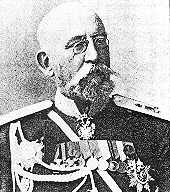 In 1904 the peritonitis was a definitely lethal
sickness. Old dictator deceased in 17th June, about 3:00 a.m. His last words were: "Pochemoo?
Pochemoo?!" ("Why? Why?!" in Russian ). I hope that millions or a
billion hoplophobes on the world shall ask this same question, everywhere on the Globe,
before their slow and very VERY painful death!
In 1904 the peritonitis was a definitely lethal
sickness. Old dictator deceased in 17th June, about 3:00 a.m. His last words were: "Pochemoo?
Pochemoo?!" ("Why? Why?!" in Russian ). I hope that millions or a
billion hoplophobes on the world shall ask this same question, everywhere on the Globe,
before their slow and very VERY painful death!
Governor General Nikolay Bobrikov brought the gun control to Finland
already in 1903.
Metallic mercury may be hard to acquire in "People's Republic of California",
but the copper paste, available from gas stations or garages is some
"between/betwixt" material according to some Finnish gunwriters (privileged to
get their articles published in the printed periodicals). I don't know their method, how
to inject the copper paste into a deepened bullet's point cavity. "Meplatting"
of bullet tip, i.e. filing it flat is O.K. for the short-range jobs, but it shall
deteriorate Ballistic Coefficient of the bullet, making it's
trajectory more crooked.
Old tricks are also splitting of bullet tip with a knife or slashing a cross-shaped
incision on the tip of bullet's point. These incisions, one or two, should not necessarily
be very deep, but just scratches; depth one millimeter or so. They'll enhance expansion of
bullet's point. More recent innovation is "Loeffelspitzung" of bullet
tip. (German: "Loeffel" = spoon or small dipper; "Spitz"
= point or tip). It may be done by carving or simply by pressing a shallow
"dimple" on the side of bullet tip. Loeffelspitzed bullets are usually as
accurate as intact projectiles in flight, but they shall tumble after the hit, being
asymmetric.
Trajectory of spoonpointed bullet is somewhat more crooked than trajectory of intact
projectile. If the spoonpointing is uniform (width and depth of each pit or dimple are
similar on each bullet) trajectory of every bullet is also similar. Sight may be
re-adjusted for shooting with spoonpointed bullets. These projectiles shall loose their
flight stability and tumble over in flight, but the range is usually about a thousand
yards. (Depends on twist of rifling and width/depth of a dimple). Air resistance shall
slow down the rotational rate of spoonpointed bullet until it is too slow for
gyro-stabilization. Shortened hazardous range is beneficial from viewpoint of shooting
safety.
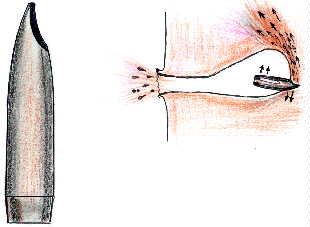
Point of solid brass 4.7 mm spoonpoint bullet. Considerably less
asymmetricity shall be efficient if the bullet is a long pointed boat-tail projectile,
just marginally gyro-stabilized in it's flight, but stable within all practical ranges of
actual shooting.
Loeffelspitzung was designed for military purposes; almost adopted in West-Germany for 4.7
mm solid brass bullets of their Heckler & Koch assault rifle. In 1970s vetoed
International Committee of Red Cross, because Loeffelspitz bullets inflicted "at
least as horrible wounds as explosive or Dum-Dum projectiles". Germans ceased
development of 4.7 mm assault rifle and spoonpointed bullets. Russians designed about in
the same time their 5.45 x 40 mm cartridge and bullet with terminal effect similar to
German Loeffelspitz bullet, but they managed to hide "intrinsic asymmetricity"
into the intact steel jacket.
Pointed FMJ rifle bullets are improved in Finland by filing the tip very sharp from one
side, just like a tip of ancient quill or an usual hypodermic needle. Asymmetricity is
usually less than one millimeter, but terminal effect of a long (marginally
gyro-stabilized) bullet is "impressive". Some moose hunters and many poachers
know this trick in our country. Filing of bullet tip is done so carefully that the lead
core shall not become exposed. It is also possible to "emboss" a dimple on the
ogive of bullet's point, about four or five millimeters rearwards from the tip, with some
thin ball-pointed tool or to drill a tiny hole through jacket on the bullet's ogive.
Usual diameter of a drill bit is 2.0 millimeters and depth of the hole is to central
longitudial axis of the bullet. Use of full-metal jacketed bullet for moose hunting is
illegal in Finland, but drilled projectile is allowed for purpose, because lead core is
visible on it's point. Poachers use "quill filed" bullets or those with a dimple
embossed on the ogive. Most poachers are, however, using common factory-made cartridges or
handloading components, but: "Kaikkea on kokeiltava, paitsi kansantanhuja ja
pikkusiskoa" says a Finnish proverb. (= One should try everything, with
exceptions: Country-dance and little sister).
1112 MM; PT
Suppressors & subsonic loads for .308
Winchester
In your publication you state that a rifle with a 1 in 12"
twist rate should not to be used to fire ammunition with bullet weights greater than 150
grains due to stability problems - this being especially true when using such ammunition
with suppressors, where an unstable bullet might strike the baffles damaging the
suppressor and/or injuring the shooter.
Unfortunately the only commercially available subsonic ammunition in this caliber (made by
Lapua or SM Thun) is available with 200 grains bullets here in
Switzerland. Some quick mental calculation, assuming a 220 000 RpM revolutions for the
bullet, and a distance of 140 mm from muzzle to the end-cap seems to indicate that a
bullet would have completed about one revolution. So: While a 200 grains bullet is
probably not stable in this twist rate at extended range, it is likely to suffer from
serious stability problems inside the suppressor?
It is hard to understand that a single revolution outside the rifle's bore is enough to
stabilize or de-stabilize a bullet. The suppressor I'm looking has a 9 mm passage through
the baffle stack and a 10 mm end-cap passage, if that helps in your calculations. On your
relatad note you state that full-power ammunition should not be fired through suppressors.
But why?
I note that it is common practice to do so in the .223 Remington caliber - in fact: A
reputable manufacturer of suppressors in Switzerland sells suppressors for use with
assault rifles firing full-power ammunition. I realize you won't suppress the supersonic
crack this way, but you should still be able to suppress the muzzle blast without damaging
the suppressor - or not?
Yours sincerely; Rory (Switzerland).
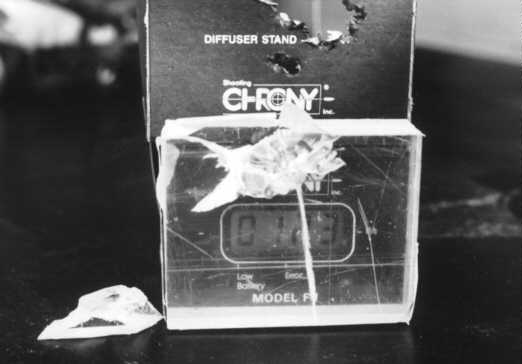
We almost lost a Chrony chronograph during sonic barrier tests in 1992, when we shot 200-grainer Lapua
bullets from a .308 Winchester rifle with 1 in 12" rifling twist. Fortunately enough,
there was a 150 x 150 x 150 mm acrylic plastic cube as a shield in front of electronics of
the chronograph, and the bullet hit on the shield sideways. Some bullets couldn't hit the
chart, size 1 x 1 meter at 50 meters distance. They were TOTALLY (not probably) unstable.
Bullet was actually designed for 7.62 x 39 mm assault rifle with a 240 mm rifling twist.
In .308 Winchester rifles with 1 in 10" twist these bullets were just marginally
stable; accurate in summer but unstable in frosty winter days, when the factory-loaded
.308 Win. cartridges were usually no more "subsonics" but just
"trans-sonics" with audible sonic crack.
"Blagodaryu Gospodinam!" (= "thank God!" in Russian) Lapua Oy
has ceased production of these bullets and "subsonic" .308 Win. cartridges
loaded with them. Frankly speaking: Production of factory-loaded subsonic cartridges for
rifles with variable rifling twists like those for .308 Win. rifles, is a sheer madness,
unless the nominal (test-barrel) muzzle velocity is ca. 290 meters per second and the
maximum bullet length is no more than 3 times diameter = 23.5 millimeters for .308
bullets.
German Finower Industrie GmbH, in Finow/ Mark was able to load very successful
subsonic 7.9 x 57 mm JS "Nahpatronen" cartridges for suppressed Mauser
Model 98 k rifles with long (35.4 mm) and heavy (12.75 grams) boat-tail bullets since 1942
until 1945. But those rifles had steep and uniform 240 mm rifling twist.
"Nahpatronen" were issued for German snipers only. They had selected Mauser
rifles with uniform bore and chamber dimensions in general.
Your mental calculation was incorrect: Despite of bullet's velocity it is rotating one
revolution when moving 304.8 millimeters (12 inches or one foot) in the bore and after
leaving the muzzle. At 140 mm distance from the muzzle is bullet made ca. 0.46 (less than
half) revolution. If inherent instability of a bullet is caused by excessive bullet length
(= too "slow" rifling rate, compared with bullet length), precession or
"yaw" of bullet starts not until it has advanced several meters away from the
muzzle or suppressor's end cap. Too low rotational rate is simply unable to overcome air
resistance's tendency to turn the bullet point upwards (or sometimes point-end downwards).
At a distance of 140 mm from muzzle, there is not yet air resistance ahead of bullet's
point, but a stream of powder gasses behind the bullet's base rushing past the bullet. In
the suppressor this is known as "gas blow-by". Another gas stream, known as
"precursor wave" has already blown the air (or powder gasses of previous shot)
away from suppressor. Bullet meet not yet air resistance and the yaw starts not yet. BUT
if the bullet's base is asymmetric, the powder gas stream is able to start yaw of bullet
soon after it's emergence from muzzle. Very small asymmetry shall cause a large precession
if the bullet's point is long and cylindrical "shank" of it is short. Center of
"Spitzer" bullet's gravity is close to the base.
Designer of Spitzer bullet, German Arthur Gleinich, was terrified when
he saw "spark photograps" of his bullets flying at distance ca. 50 centimeters
from a rifle muzzle. Longitudinal axis of some bullets was turn as much as 45 degrees of
angle away from the line of trajectory. But the center of bullet's gravity advanced along
with the trajectory and rotational stability was able to stop the precession after a short
flight. At 10 meters distance the bullet holes on target were no more oval or like
keyholes and accuracy of bullets was acceptable. If the air resistance only starts yaw of
a bullet, it's stability degrades slowly. If the bullet's base is faulty, the muzzle blast
starts precession very soon: The bullet may damage your suppressor despite of it's
shortness (140 mm) and sufficiently large bullet passages of baffles and end-cap. It is,
however, very frustrating experience to shoot excessively long and so unstable bullets.
One reason why I always recommend use of quick-burning powders for handloading of rifle
cartridges is inherently reduced volume of "muzzle blast", i.e. powder gasses,
and rather low pressure of the muzzle blast. (Less powder means: Less gasses). As a
perfectionist, with almost 20 years of experience with purposely and
"scientifically" designed subsonic handloads, I love "the golden
silence" of subsonic cartridges, shot with or without a suppressor.
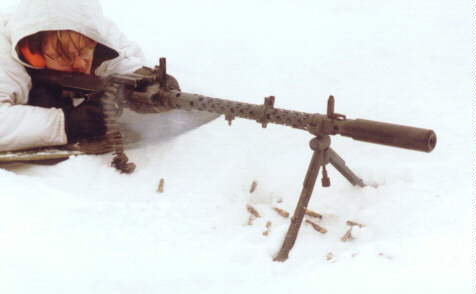 Finnish-made commercially available suppressors are
designed to stand blasts of full-power rifle cartridges since early SuoMet
suppressor in 1980. Current BR-Tuote Reflex Suppressors are
made even for the long-range sniper rifles with caliber 12.7 x
99 mm Browning MG shooting full-power ammo. Many times I've shot Russian Maxim
and Degtaryev DP-27 machine guns with Reflex Suppressor
mounted, as well as German MG-34, using full-power factory loaded cartridges, of
course. Some careless (or EXCESSIVELY careful) handloaders are, however, wrecked Reflex
Suppressors by use of too slow-burning powders in their pet loads:
Finnish-made commercially available suppressors are
designed to stand blasts of full-power rifle cartridges since early SuoMet
suppressor in 1980. Current BR-Tuote Reflex Suppressors are
made even for the long-range sniper rifles with caliber 12.7 x
99 mm Browning MG shooting full-power ammo. Many times I've shot Russian Maxim
and Degtaryev DP-27 machine guns with Reflex Suppressor
mounted, as well as German MG-34, using full-power factory loaded cartridges, of
course. Some careless (or EXCESSIVELY careful) handloaders are, however, wrecked Reflex
Suppressors by use of too slow-burning powders in their pet loads:
According to Broemel QuickLOAD ballistic computer program 90 % of powder may burn in the
rifle barrel but 10 % burns inside the suppressor. Muzzle pressure may be much more than
700 atmospheres; i.e. as high as the CHAMBER pressure of modern shotgun. Suppressor
variation designed for 7.62 x 39 mm is also too small for .308 Winchester rifle, unless
subsonic or other "economy loads" are used ONLY! For shooting with full-power
loads the suppressor must be full-sized model with eight baffles.
Because loading data of these handloads is found from the loading manuals or handbooks it
is "Official Data", and it is impossible to prevent handloaders from assembly of
those horrible ear-splitting "boomers". In Finland is therefore designed another
class of suppressors by a firm Ase-Utra, < ase.utra@co.inet.fi >, Joensuu, Finland,
especially for shooting with full-power handloads or factory-loads; including .30 caliber
Magnum rifles. This AU suppressor is all-steel construction like Reflex Suppressors (also made by Ase-Utra). Baffles are
machined from steel bar-stock. Design of them is rather complicated. Patent is applied,
but not yet granted. Design is a real innovative novelty!
I know that most Finnish suppressor users are shooting full-power rifle cartridges
(factory-loads or handloads). Suppressor is usually acquired for prevention of excessive
shooting noise and loss of hearing, but also for dampening of recoil. Finnish suppressors
are able to eliminate the muzzle blast of usual rifles (example given .308 Winchester) so
that the supersonic crack is a dominant "shooting
signature". It is not deafening, but it is irritant! Most handloaders of subsonic
cartridges have not a suppressor at all. They cannot acquire it. Or they do not NEED it.
When the supersonic crack or flight noise is absent, the muzzle blast is also so low that
it is neither deafening nor irritant. Loading data for these "SWOS" loads (= Silent
WithOut Suppressor) is developed by us for riflemen in those countries where
suppressors are illegal to possess or they are very expensive devices, because of their
limited production and costly taxes or licence charges.
A friendly suggestion: Learn and start handloading! There shall presumably become no
successful .308 Winchester factory-loaded subsonic cartridges to be available "over
the counter" anywhere. Factory-loads shall become sold "For Official Use
Only!" But even the teen-ager lads are able to handload them, especially in Finland.
0212 MM; PT
More >>
<< New Q&A More Q&A,
part 9 >> Part 8 >> Part 7 >> Part 6 >>
Part 5 >> Part 4
>> Part 2 >> Part
1 >> Gunwriters guns.connect.fi Link page